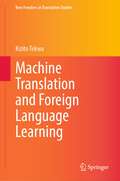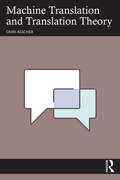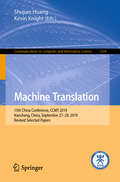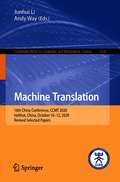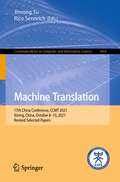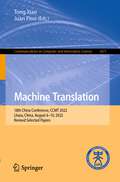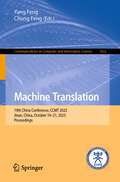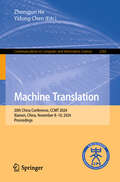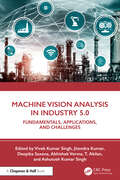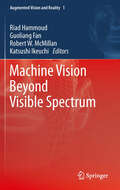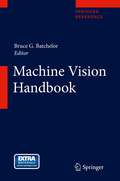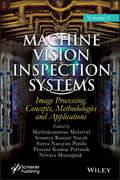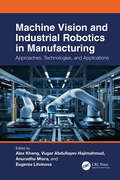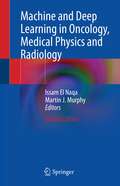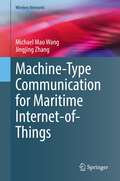- Table View
- List View
Machine Translation and Foreign Language Learning (New Frontiers in Translation Studies)
by Kizito TekwaThe book investigates how machine translation (MT) provides opportunities and increases the willingness to communicate in a foreign language. It is informed by a mixed methods methodological approach that analyzes quantitative and qualitative data of questionnaires and real-time instant messages (IM). The book is unique because it contains tables, figures, and screenshots of actual real-time IM exchanges. It is innovative in discussing IM translation, a novel form of MT, and demonstrates how the technology offers English foreign language learners, in this case, Chinese college students, communication opportunities while increasing their willingness to communicate. The study provides an interesting insight into IM user profiles, clients, and usages. Smartphone screenshots are the locale of the study whose findings have far-reaching implications for students, language and translation instructors, and curriculum designers.
Machine Translation and Translation Theory
by Omri AsscherPervasive and ubiquitous, machine translation systems have been transforming communication and understanding across languages and cultures on a historical scale. Focused on both Neural Machine Translation tools, such as Google Translate, and generative AI tools, such as ChatGPT, Omri Asscher pursues the juncture between machine translation and the diverse, often competing, frameworks of human translation theory. He shines a light on the subtleties of the intersection between the two: the places where machine translation corresponds well with the ideas that have been developed on human translation throughout the years, and the places where machine translation seems to challenge translation theory, and perhaps even require that we rethink some of its basic assumptions.Machine Translation and Translation Theory reflects the need for an accessible, panoramic view on the subject. It offers a detailed discussion of various points of theoretical interest: definitions of translation; equivalence in translation; aesthetics of translation; translation ethics; translation as cross-cultural communication; and translation's historical agency.This is key reading for researchers and students in translation studies, as well as scholars of AI-mediated communication, and computer scientists interested in how machine translation architectures correspond with the understanding of translation in the humanities.
Machine Translation and Transliteration involving Related, Low-resource Languages
by Pushpak Bhattacharyya Anoop KunchukuttanMachine Translation and Transliteration involving Related, Low-resource Languages discusses an important aspect of natural language processing that has received lesser attention: translation and transliteration involving related languages in a low-resource setting. This is a very relevant real-world scenario for people living in neighbouring states/provinces/countries who speak similar languages and need to communicate with each other, but training data to build supporting MT systems is limited. The book discusses different characteristics of related languages with rich examples and draws connections between two problems: translation for related languages and transliteration. It shows how linguistic similarities can be utilized to learn MT systems for related languages with limited data. It comprehensively discusses the use of subword-level models and multilinguality to utilize these linguistic similarities. The second part of the book explores methods for machine transliteration involving related languages based on multilingual and unsupervised approaches. Through extensive experiments over a wide variety of languages, the efficacy of these methods is established. Features Novel methods for machine translation and transliteration between related languages, supported with experiments on a wide variety of languages. An overview of past literature on machine translation for related languages. A case study about machine translation for related languages between 10 major languages from India, which is one of the most linguistically diverse country in the world. The book presents important concepts and methods for machine translation involving related languages. In general, it serves as a good reference to NLP for related languages. It is intended for students, researchers and professionals interested in Machine Translation, Translation Studies, Multilingual Computing Machine and Natural Language Processing. It can be used as reference reading for courses in NLP and machine translation. Anoop Kunchukuttan is a Senior Applied Researcher at Microsoft India. His research spans various areas on multilingual and low-resource NLP. Pushpak Bhattacharyya is a Professor at the Department of Computer Science, IIT Bombay. His research areas are Natural Language Processing, Machine Learning and AI (NLP-ML-AI). Prof. Bhattacharyya has published more than 350 research papers in various areas of NLP.
Machine Translation: 14th China Workshop, Cwmt 2018, Wuyishan, China, October 25-26, 2018, Proceedings (Communications in Computer and Information Science #954)
by Jiajun Chen Jiajun ZhangThis book constitutes the refereed proceedings of the 14th China Workshop on Machine Translation, CWMT 2018, held in Wuyishan, China, in October 2018. The 9 papers presented in this volume were carefully reviewed and selected from 17 submissions and focus on all aspects of machine translation, including preprocessing, neural machine translation models, hybrid model, evaluation method, and post-editing.
Machine Translation: 15th China Conference, CCMT 2019, Nanchang, China, September 27–29, 2019, Revised Selected Papers (Communications in Computer and Information Science #1104)
by Kevin Knight Shujian HuangThis book constitutes the refereed proceedings of the 15th China Conference on Machine Translation, CCMT 2019, held in Nanchang, China, in September 2019.The 10 full papers presented in this volume were carefully reviewed and selected from 21 submissions and focus on all aspects of machine translation, including preprocessing, neural machine translation models, hybrid model, evaluation method, and post-editing.
Machine Translation: 16th China Conference, CCMT 2020, Hohhot, China, October 10-12, 2020, Revised Selected Papers (Communications in Computer and Information Science #1328)
by Junhui Li Andy WayThis book constitutes the refereed proceedings of the 16th China Conference on Machine Translation, CCMT 2020, held in Hohhot, China, in October 2020. The 13 papers presented in this volume were carefully reviewed and selected from 78 submissions and focus on all aspects of machine translation, including preprocessing, neural machine translation models, hybrid model, evaluation method, and post-editing.
Machine Translation: 17th China Conference, CCMT 2021, Xining, China, October 8–10, 2021, Revised Selected Papers (Communications in Computer and Information Science #1464)
by Jinsong Su Rico SennrichThis book constitutes the refereed proceedings of the 17th China Conference on Machine Translation, CCMT 2020, held in Xining, China, in October 2021. The 10 papers presented in this volume were carefully reviewed and selected from 25 submissions and focus on all aspects of machine translation, including preprocessing, neural machine translation models, hybrid model, evaluation method, and post-editing.
Machine Translation: 18th China Conference, CCMT 2022, Lhasa, China, August 6–10, 2022, Revised Selected Papers (Communications in Computer and Information Science #1671)
by Tong Xiao Juan PinoThis book constitutes the refereed proceedings of the 18th China Conference onMachine Translation, CCMT 2022, held in Lhasa, China, during August 6–10, 2022.The 16 full papers were included in this book were carefully reviewed and selected from 73 submissions.
Machine Translation: 19th China Conference, CCMT 2023, Jinan, China, October 19–21, 2023, Proceedings (Communications in Computer and Information Science #1922)
by Yang Feng Chong FengThis book constitutes the refereed proceedings of the 19th China Conference on Machine Translation, CCMT 2023, held in Jinan, China, during October 19–21, 2023. The 8 full papers and 3 short papers included in this book were carefully reviewed and selected from 71 submissions. They focus on machine translation; improvement of translation models and systems; translation quality estimation; document-level machine translation; low-resource machine translation.
Machine Translation: 20th China Conference, CCMT 2024, Xiamen, China, November 8–10, 2024, Proceedings (Communications in Computer and Information Science #2365)
by Yidong Chen Zhongjun HeThis book constitutes the refereed proceedings of the 20th China Conference on Machine Translation, CCMT 2024, which took place in Xiamen, China, during November 8–10, 2024. The 13 full papers included in this book were carefully reviewed and selected from 52 submissions. They were organized in topical sections as follows: robustness and efficiency of translation models; low-resource machine translation; quality estimation; large language modes for machine translation; multi-modal translation; and machine translation evaluation.
Machine Understanding: Machine Perception and Machine Perception MU (Studies in Computational Intelligence #842)
by Zbigniew Les Magdalena LesThis unique book discusses machine understanding (MU). This new branch of classic machine perception research focuses on perception that leads to understanding and is based on the categories of sensory objects. In this approach the visual and non-visual knowledge, in the form of visual and non-visual concepts, is used in the complex reasoning process that leads to understanding. The book presents selected new concepts, such as perceptual transformations, within the machine understanding framework, and uses perceptual transformations to solve perceptual problems (visual intelligence tests) during understanding, where understanding is regarded as an ability to solve complex visual problems described in the authors’ previous books. Thanks to the uniqueness of the research topics covered, the book appeals to researchers from a wide range of disciplines, especially computer science, cognitive science and philosophy.
Machine Vision Analysis in Industry 5.0: Fundamentals, Applications, and Challenges
by Jitendra Kumar Abhishek Verma Vivek Kumar Singh Ashutosh Kumar Singh Deepika Saxena T. AkilanThis book is an introduction to fundamental techniques of image analysis with machine vision and their applicability in Industry 5.0. It provides basic and emerging techniques in the field of image analysis and machine vision in Industry 5.0. It also covers an extensive study of recent related work and research challenges in the field. Further, it discusses some effective solutions to address the challenges of digitally transforming industrial activities and improving their efficiency. Provides effective and robust machine vision-enabled methods across different industrial fields, emphasizing their applicability and reliability Covers the emerging concepts of image analysis and machine vision utilized in the digital transformation of manufacturing activities under Industry 5.0 Discusses conceptual methodologies of image analysis and machine vision tailored for various industrial applications, providing insights into their practical implementation Practical issues on implementing machine vision applications with image analysis techniques in Industry 5.0 are addressed, offering guidance on method implementation Includes case studies of various industrial processes, highlighting current challenges and presenting effective solutions, offering real-world insights into the application of machine vision It is a reference book for research students, scientists, and professionals working in the fields of image processing, computer vision, and the Internet of Things.
Machine Vision Beyond Visible Spectrum
by Riad Hammoud Katsushi Ikeuchi Robert W. Mcmillan Guoliang FanThe material of this book encompasses many disciplines, including visible, infrared, far infrared, millimeter wave, microwave, radar, synthetic aperture radar, and electro-optical sensors as well as the very dynamic topics of image processing, computer vision and pattern recognition. This book is composed of six parts: * Advanced background modeling for surveillance * Advances in Tracking in Infrared imagery * Methods for Pose estimation in Ultrasound and LWIR imagery * Recognition in multi-spectral and synthetic aperture radar * Fusion of disparate sensors * Smart Sensors
Machine Vision Handbook
by Bruce G. BatchelorThe automation of visual inspection is becoming more and more important in modern industry as a consistent, reliable means of judging the quality of raw materials and manufactured goods . The Machine Vision Handbook equips the reader with the practical details required to engineer integrated mechanical-optical-electronic-software systems. Machine vision is first set in the context of basic information on light, natural vision, colour sensing and optics. The physical apparatus required for mechanized image capture - lenses, cameras, scanners and light sources - are discussed followed by detailed treatment of various image-processing methods including an introduction to the QT image processing system. QT is unique to this book, and provides an example of a practical machine vision system along with extensive libraries of useful commands, functions and images which can be implemented by the reader. The main text of the book is completed by studies of a wide variety of applications of machine vision in inspecting and handling different types of object.
Machine Vision Inspection Systems, Machine Learning-Based Approaches
by Prasant Kumar Pattnaik Muthukumaran Malarvel Soumya Ranjan Nayak Surya Narayan PandaMachine Vision Inspection Systems (MVIS) is a multidisciplinary research field that emphasizes image processing, machine vision and, pattern recognition for industrial applications. Inspection techniques are generally used in destructive and non-destructive evaluation industry. Now a day's the current research on machine inspection gained more popularity among various researchers, because the manual assessment of the inspection may fail and turn into false assessment due to a large number of examining while inspection process. This volume 2 covers machine learning-based approaches in MVIS applications and it can be employed to a wide diversity of problems particularly in Non-Destructive testing (NDT), presence/absence detection, defect/fault detection (weld, textile, tiles, wood, etc.,), automated vision test & measurement, pattern matching, optical character recognition & verification (OCR/OCV), natural language processing, medical diagnosis, etc. This edited book is designed to address various aspects of recent methodologies, concepts, and research plan out to the readers for giving more depth insights for perusing research on machine vision using machine learning-based approaches.
Machine Vision Inspection Systems: Image Processing, Concepts, Methodologies, and Applications
by Prasant Kumar Pattnaik Muthukumaran Malarvel Soumya Ranjan Nayak Surya Narayan Panda Nittaya MuangnakThis edited book brings together leading researchers, academic scientists and research scholars to put forward and share their experiences and research results on all aspects of an inspection system for detection analysis for various machine vision applications. It also provides a premier interdisciplinary platform to present and discuss the most recent innovations, trends, methodology, applications, and concerns as well as practical challenges encountered and solutions adopted in the inspection system in terms of image processing and analytics of machine vision for real and industrial application.Machine vision inspection systems (MVIS) utilized all industrial and non-industrial applications where the execution of their utilities based on the acquisition and processing of images. MVIS can be applicable in industry, governmental, defense, aerospace, remote sensing, medical, and academic/education applications but constraints are different. MVIS entails acceptable accuracy, high reliability, high robustness, and low cost. Image processing is a well-defined transformation between human vision and image digitization, and their techniques are the foremost way to experiment in the MVIS. The digital image technique furnishes improved pictorial information by processing the image data through machine vision perception. Digital image processing has widely been used in MVIS applications and it can be employed to a wide diversity of problems particularly in Non-Destructive testing (NDT), presence/absence detection, defect/fault detection (weld, textile, tiles, wood, etc.,), automated vision test & measurement, pattern matching, optical character recognition & verification (OCR/OCV), barcode reading and traceability, medical diagnosis, weather forecasting, face recognition, defence and space research, etc. This edited book is designed to address various aspects of recent methodologies, concepts and research plan out to the readers for giving more depth insights for perusing research on machine vision using image processing techniques.
Machine Vision and Augmented Intelligence: Select Proceedings of MAI 2022 (Lecture Notes in Electrical Engineering #1007)
by Manish Kumar Bajpai Koushlendra Kumar Singh Akbar Sheikh AkbariThis book comprises the proceedings of the International Conference on Machine Vision and Augmented Intelligence (MAI 2022). The conference proceedings encapsulate the best deliberations held during the conference. The diversity of participants in the event from academia, industry, and research reflects in the articles appearing in the book. The book encompasses all industrial and non-industrial applications. This book covers a wide range of topics such as modeling of disease transformation, epidemic forecast, image processing, and computer vision, augmented intelligence, soft computing, deep learning, image reconstruction, artificial intelligence in health care, brain-computer interface, cybersecurity, social network analysis, and natural language processing.
Machine Vision and Augmented Intelligence: Select Proceedings of MAI 2023 (Lecture Notes in Electrical Engineering #1211)
by Sangeeta Singh Manish Kumar Bajpai Koushlendra Kumar Singh Subodh SrivastavaThis book comprises the proceedings of the International Conference on Machine Vision and Augmented Intelligence (MAI 2023). The conference proceedings encapsulate the best deliberations held during the conference. The diversity of participants in the event from academia, industry, and research reflects in the articles appearing in the volume. The book theme encompasses all industrial and non-industrial applications in which a combination of hardware and software provides operational guidance to devices in the execution of their functions based on the capture and processing of images. This book covers a wide range of topics such as modeling of disease transformation, epidemic forecast, COVID-19, image processing and computer vision, augmented intelligence, soft computing, deep learning, image reconstruction, artificial intelligence in healthcare, brain-computer interface, cybersecurity, and social network analysis, natural language processing, etc.
Machine Vision and Augmented Intelligence—Theory and Applications: Select Proceedings of MAI 2021 (Lecture Notes in Electrical Engineering #796)
by Manish Kumar Bajpai Koushlendra Kumar Singh George GiakosThis book comprises the proceedings of the International Conference on Machine Vision and Augmented Intelligence (MAI 2021) held at IIIT, Jabalpur, in February 2021. The conference proceedings encapsulate the best deliberations held during the conference. The diversity of participants in the event from academia, industry, and research reflects in the articles appearing in the volume. The book theme encompasses all industrial and non-industrial applications in which a combination of hardware and software provides operational guidance to devices in the execution of their functions based on the capture and processing of images. This book covers a wide range of topics such as modeling of disease transformation, epidemic forecast, COVID-19, image processing and computer vision, augmented intelligence, soft computing, deep learning, image reconstruction, artificial intelligence in healthcare, brain-computer interface, cybersecurity, and social network analysis, natural language processing, etc.
Machine Vision and Industrial Robotics in Manufacturing: Approaches, Technologies, and Applications
by Alex Khang Anuradha Misra Eugenia Litvinova Vugar Abdullayev HajimahmudThis book covers the basics of machine vision and robotics in the manufacturing industry. Major applicability of intelligent machines and robotics in the manufacturing sector are explored in three major areas of product traceability, remote product-monitoring, supply chain, logistics, and product record management. Machine Vision and Industrial Robotics in Manufacturing: Approaches, Technologies, and Applications explains advanced technologies based on Artificial Intelligence and Industrial Internet of Things related to smart manufacturing applications.The book introduces the emerging machines and robotics applications that are enabling smart factories initiatives worldwide. The chapters examine labor productivity, factory device installation, and defective product detection. The authors share modern models, emerging technologies, designs, frameworks, theories, practices, and sustainable approaches to design and implement machine vision with industrial robotics. They also examine the challenging issues associated with the leveraging of technologies related to machine vision, computer vision, robotics, Internet of Things, Industrial Internet of Things technologies, Artificial Intelligence-equipped machines, applications, and automatic techniques for intelligent manufacturing systems and smart factory infrastructure in the era of Industry 4.0 manufacturing. The authors also examine topics such as the role of existing management and production solutions, their limitations, and future directions in manufacturing industry.This book targets a mixed audience of students, engineers, scholars, researchers, academics, and professionals who are learning, researching, and working in the field of machine vision, Artificial Intelligence, Industrial Internet of Things, computer vision, and robotic technologies from different industries and economics.
Machine Vision and Navigation
by Oleg Sergiyenko Wendy Flores-Fuentes Paolo MercorelliThis book presents a variety of perspectives on vision-based applications. These contributions are focused on optoelectronic sensors, 3D & 2D machine vision technologies, robot navigation, control schemes, motion controllers, intelligent algorithms and vision systems. The authors focus on applications of unmanned aerial vehicles, autonomous and mobile robots, industrial inspection applications and structural health monitoring. Recent advanced research in measurement and others areas where 3D & 2D machine vision and machine control play an important role, as well as surveys and reviews about vision-based applications. These topics are of interest to readers from diverse areas, including electrical, electronics and computer engineering, technologists, students and non-specialist readers.• Presents current research in image and signal sensors, methods, and 3D & 2D technologies in vision-based theories and applications; • Discusses applications such as daily use devices including robotics, detection, tracking and stereoscopic vision systems, pose estimation, avoidance of objects, control and data exchange for navigation, and aerial imagery processing; • Includes research contributions in scientific, industrial, and civil applications.
Machine Vision for Industry 4.0: Applications and Case Studies
by Roshani RautThis book discusses the use of machine vision and technologies in specific engineering case studies and focuses on how machine vision techniques are impacting every step of industrial processes and how smart sensors and cognitive big data analytics are supporting the automation processes in Industry 4.0 applications. Industry 4.0, the Fourth Industrial Revolution, combines traditional manufacturing with automation and data exchange. Machine vision is used in the industry for reliable product inspections, quality control, and data capture solutions. It combines different technologies to provide important information from the acquisition and analysis of images for robot-based inspection and guidance. Features Presents a comprehensive guide on how to use machine vision for Industry 4.0 applications, such as analysis of images for automated inspections, object detection, object tracking, and more Includes case studies of Robotics Internet of Things with its current and future applications in healthcare, agriculture, and transportation Highlights the inclusion of impaired people in the industry, for example, an intelligent assistant that helps deaf-mute individuals to transmit instructions and warnings in a manufacturing process Examines the significant technological advancements in machine vision for Industrial Internet of Things and explores the commercial benefits using real-world applications from healthcare to transportation Discusses a conceptual framework of machine vision for various industrial applications The book addresses scientific aspects for a wider audience such as senior and junior engineers, undergraduate and postgraduate students, researchers, and anyone interested in the trends, development, and opportunities for machine vision for Industry 4.0 applications.
Machine Vision in Plant Leaf Disease Detection for Sustainable Agriculture (Studies in Computational Intelligence #1202)
by Nilanjan Dey M. F. MridhaThis book offers a comprehensive exploration of the intersection between advanced technology and agricultural sustainability. With a focus on leveraging machine vision techniques for the early detection and management of plant diseases, this book serves as a vital resource for researchers, practitioners, and stakeholders in the agricultural sector. The book begins by providing an overview of the challenges posed by plant diseases to global food security and agricultural sustainability. It highlights the limitations of traditional disease detection methods and underscores the need for innovative approaches that can offer timely and accurate diagnosis. Through a systematic examination of machine vision principles and methodologies, the book delves into the various stages of disease detection, from image acquisition to feature extraction and classification. Key concepts such as image preprocessing, feature selection, and machine learning algorithms are discussed in detail, with emphasis on their practical implementation in real-world scenarios. Moreover, the book explores the potential of machine vision to contribute to sustainable agriculture practices.
Machine and Deep Learning in Oncology, Medical Physics and Radiology
by Issam El Naqa Martin J. MurphyThis book, now in an extensively revised and updated second edition, provides a comprehensive overview of both machine learning and deep learning and their role in oncology, medical physics, and radiology. Readers will find thorough coverage of basic theory, methods, and demonstrative applications in these fields. An introductory section explains machine and deep learning, reviews learning methods, discusses performance evaluation, and examines software tools and data protection. Detailed individual sections are then devoted to the use of machine and deep learning for medical image analysis, treatment planning and delivery, and outcomes modeling and decision support. Resources for varying applications are provided in each chapter, and software code is embedded as appropriate for illustrative purposes. The book will be invaluable for students and residents in medical physics, radiology, and oncology and will also appeal to more experienced practitioners and researchers and members of applied machine learning communities.
Machine-Type Communication for Maritime Internet-of-Things: From Concept to Practice (Wireless Networks)
by Jingjing Zhang Michael Mao WangThis book introduces the concept of machine-type communication (MTC) for maritime Internet of Things. The first part of the book portrays a maritime MTC system from an architectural perspective and describes an MTC framework and the fundamental components, laying out a foundation that leads to an ultimate solution to the maritime IoT requirements and challenges. The second part ties together all discussed in the first part and demonstrates how to apply it to a practical system through a realistic design example based on an international maritime mobile spectrum. The book serves as a comprehensive tutorial of the maritime MTC from the top (the network architecture) to the bottom (the air/radio interface and regulatory radio spectrum constraints), guiding readers to an easier understanding of the maritime MTC-related issues and the rationale behind the design. The primary readers of this book include maritime communication engineers, maritime IoT professionals, maritime academia, and the general MTC and IoT communities.Presents the concept of machine-type communication (MTC) for maritime Internet of Things (IoT) and its services, requirements, and challenges;Explains space-earth-integrated maritime machine-type communication system architecture with a comparison with its land counterpart;Sets out a comprehensive framework and details the ways to implement it on a practical radio spectrum;Includes maritime MTC radio spectrum and regulations, network design, protocol design, and air interface design.
